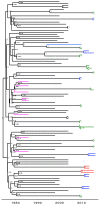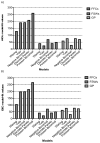Phylogenetic Networks and Parameters Inferred from HIV Nucleotide Sequences of High-Risk and General Population Groups in Uganda: Implications for Epidemic Control
- PMID: 34073846
- PMCID: PMC8225143
- DOI: 10.3390/v13060970
Phylogenetic Networks and Parameters Inferred from HIV Nucleotide Sequences of High-Risk and General Population Groups in Uganda: Implications for Epidemic Control
Abstract
Phylogenetic inference is useful in characterising HIV transmission networks and assessing where prevention is likely to have the greatest impact. However, estimating parameters that influence the network structure is still scarce, but important in evaluating determinants of HIV spread. We analyzed 2017 HIV pol sequences (728 Lake Victoria fisherfolk communities (FFCs), 592 female sex workers (FSWs) and 697 general population (GP)) to identify transmission networks on Maximum Likelihood (ML) phylogenetic trees and refined them using time-resolved phylogenies. Network generative models were fitted to the observed degree distributions and network parameters, and corrected Akaike Information Criteria and Bayesian Information Criteria values were estimated. 347 (17.2%) HIV sequences were linked on ML trees (maximum genetic distance ≤4.5%, ≥95% bootstrap support) and, of these, 303 (86.7%) that consisted of pure A1 (n = 168) and D (n = 135) subtypes were analyzed in BEAST v1.8.4. The majority of networks (at least 40%) were found at a time depth of ≤5 years. The waring and yule models fitted best networks of FFCs and FSWs respectively while the negative binomial model fitted best networks in the GP. The network structure in the HIV-hyperendemic FFCs is likely to be scale-free and shaped by preferential attachment, in contrast to the GP. The findings support the targeting of interventions for FFCs in a timely manner for effective epidemic control. Interventions ought to be tailored according to the dynamics of the HIV epidemic in the target population and understanding the network structure is critical in ensuring the success of HIV prevention programs.
Keywords: HIV; epidemic control; model; parameters; phylodynamic; phylogenetic; populations; prevention; transmission network.
Conflict of interest statement
The authors declare no conflict of interest. The funders had no role in the design of the study; in the collection, analyses, or interpretation of data; in the writing of the manuscript, or in the decision to publish the results.
Figures



Similar articles
-
Analysis of the history and spread of HIV-1 in Uganda using phylodynamics.J Gen Virol. 2015 Jul;96(Pt 7):1890-8. doi: 10.1099/vir.0.000107. Epub 2015 Feb 27. J Gen Virol. 2015. PMID: 25724670 Free PMC article.
-
Phylogeography of HIV-1 suggests that Ugandan fishing communities are a sink for, not a source of, virus from general populations.Sci Rep. 2019 Jan 31;9(1):1051. doi: 10.1038/s41598-018-37458-x. Sci Rep. 2019. PMID: 30705307 Free PMC article.
-
Quantifying HIV transmission flow between high-prevalence hotspots and surrounding communities: a population-based study in Rakai, Uganda.Lancet HIV. 2020 Mar;7(3):e173-e183. doi: 10.1016/S2352-3018(19)30378-9. Epub 2020 Jan 14. Lancet HIV. 2020. PMID: 31953184 Free PMC article.
-
Insights on transmission of HIV from phylogenetic analysis to locally optimize HIV prevention strategies.Curr Opin HIV AIDS. 2018 Mar;13(2):95-101. doi: 10.1097/COH.0000000000000443. Curr Opin HIV AIDS. 2018. PMID: 29266012 Review.
-
Molecular tools for studying HIV transmission in sexual networks.Curr Opin HIV AIDS. 2014 Mar;9(2):126-33. doi: 10.1097/COH.0000000000000040. Curr Opin HIV AIDS. 2014. PMID: 24384502 Free PMC article. Review.
Cited by
-
Phylogenetic Insights on Patterns of HIV-1 Spread and the Design of Epidemic Control Measures.Viruses. 2022 Feb 7;14(2):332. doi: 10.3390/v14020332. Viruses. 2022. PMID: 35215925 Free PMC article.
-
The Role of Phylogenetics in Unravelling Patterns of HIV Transmission towards Epidemic Control: The Quebec Experience (2002-2020).Viruses. 2021 Aug 19;13(8):1643. doi: 10.3390/v13081643. Viruses. 2021. PMID: 34452506 Free PMC article.
-
Evidence from HIV sequencing for blood-borne transmission in Africa.J Public Health Afr. 2025 Apr 30;16(1):715. doi: 10.4102/jphia.v16i1.715. eCollection 2025. J Public Health Afr. 2025. PMID: 40356728 Free PMC article. Review.
-
Achieving the 95 95 95 targets for all: A pathway to ending AIDS.PLoS One. 2022 Aug 4;17(8):e0272405. doi: 10.1371/journal.pone.0272405. eCollection 2022. PLoS One. 2022. PMID: 35925943 Free PMC article.
-
Phylodynamics analysis of HIV epidemic history in Belarus in 1987-2022.Front Epidemiol. 2025 Jul 21;5:1601976. doi: 10.3389/fepid.2025.1601976. eCollection 2025. Front Epidemiol. 2025. PMID: 40761738 Free PMC article.
References
-
- Wabwire-Mangen F., Odiit M., Kirungi W., Kisitu D.K., Wanyama J.O. HIV Modes of Transmission and Prevention Response Analysis. Uganda National AIDS Commission; Kampala, Uganda: 2009.
-
- Vandepitte J., Bukenya J., Weiss H.A., Nakubulwa S., Francis S.C., Hughes P., Hayes R., Grosskurth H. HIV and Other Sexually Transmitted Infections in a Cohort of Women Involved in High-Risk Sexual Behavior in Kampala, Uganda. Sex. Transm. Dis. 2011;38:316–323. doi: 10.1097/OLQ.0b013e3182099545. - DOI - PMC - PubMed
-
- Uganda AIDS Commision and Ministry of Health . Multi-Sectoral HIV Programming for MARPS in Uganda: Review of Profiles, Sizes and Programme Coverage: Study Review Report. Ministry of Health and Uganda AIDS Commission; Kampala, Uganda: 2014.
Publication types
MeSH terms
Grants and funding
LinkOut - more resources
Full Text Sources
Medical
Molecular Biology Databases

